Movie Review By: SFAM
Year: 1987
Directed by: Paul Verhoeven
Written by: Edward Neumeier & Michael Miner
IMDB Reference
Degree of Cyberpunk Visuals: High
Correlation to Cyberpunk Themes: Very High
Key Cast Members:
Officer Alex J. Murphy/RoboCop: Peter Weller
Officer Anne Lewis: Nancy Allen
Dick Jones: Ronny Cox
Bob Morton: Miguel Ferrer
Clarence Boddicker (Crime Lord): Kurtwood Smith
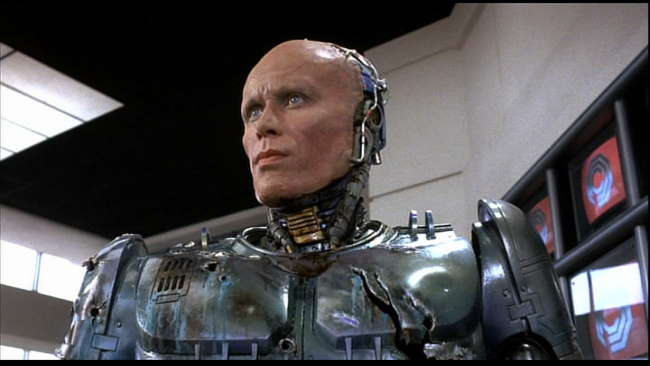
Overview: One of the truly unique movies in the cyberpunk genre, Robocop seems to be slowly receding from our conscious. No longer (in the US) is it carried at places like Best Buy. This is truly a shame because Robocop offers us one of the best instances of near-future cyborgs on film, and in the process, raises some pretty interesting questions. One top of this, Robocop offers some really fun satire along with an in-your-face realistic violence tone throughout that only adds to its mood.
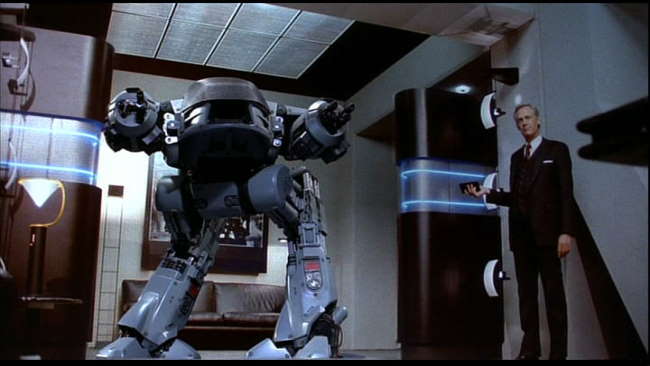
The Story: In a very near-future setting, general law and order has broken down. In the crime-ridden city of Detroit, Omni Consumer Products (OCP) has taken over the public safety duties. To cut costs, they have decided to explore options for automating the police force. One option supported by Dick Jones (Ronny Cox) the number 2 guy at OCP, involves the development of a fully automated mobile weapon system called “ED 209.” While ED 209 is an absolute badass, it screws up in the final demo and ends up peppering one of OCP’s employees in the process.
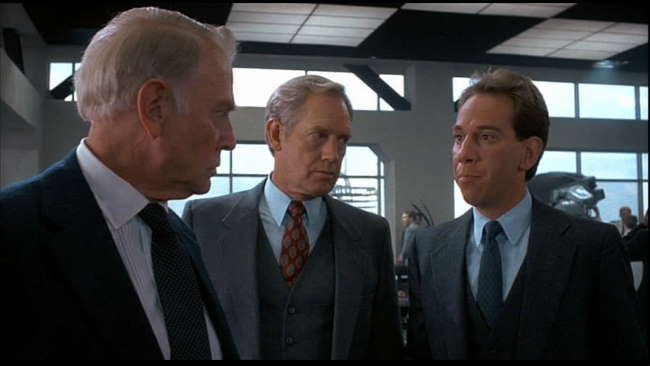
Enter up and coming executive, Bob Morton (Miguel Ferrer). Bob takes ED 209’s demise as an opportunity to convince the CEO to give the Robocop project a try. This involves taking a “just-dead” cop, and embedding the key parts of his body (brain, lungs, heart, etc.) into a robotic body that interfaces and “controls” the mental processes through controlling prime directives. Detective Murphy (played wonderfully by Peter Weller), who has just died in a gruesome death at the hands of Detroit’s crime lord (Kurtwood Smith) becomes the new “volunteer.” His memory is erased, his limbs are removed, and then becomes OCP’s corporate property as their latest innovation.
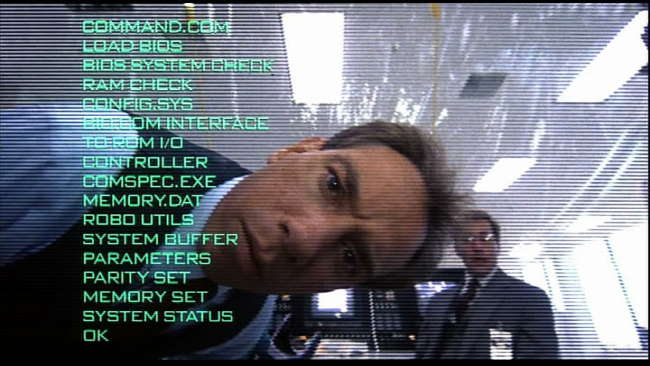
Murphy is transformed into a fully encased crime fighting machine. Robocop is released on the streets to start kicking ass. Unfortunately, Dick Jones doesn’t take his defeat gracefully, and begins to cause trouble both for Robocop’s creator, Bob Morton, and finally for Robocop. It turns out that OCP’s plan for managing detroit’s crime situation isn’t all above board, as there appears to be some linkage between OCP and Detroit’s crime lord. Robocop’s troubles get even worse as he begins to remember who he was in a past life.
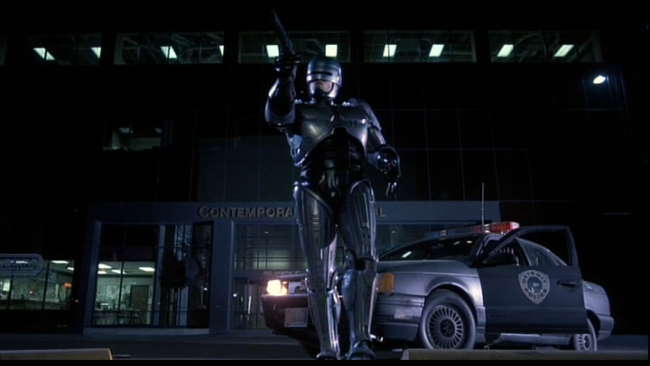
The Satire: Verhoeven is known for having an off-beat sense of satire. In a technique later used for Total Recall and Starship Troopers, Robocop does this primarily through its news reports and commercials. These, along with the corporate greed thematics transforms Robocop into a social commentary on the 80s excesses. The Commoditization of society permeates every aspect of human life in Robocop. Corporations are inherently evil and humanity is a cheap sales pitch. Like Starship Troopers, you’ll continually catch yourself smiling at the commercials and news reports, as Verhoeven really has a talent for this type of satire.
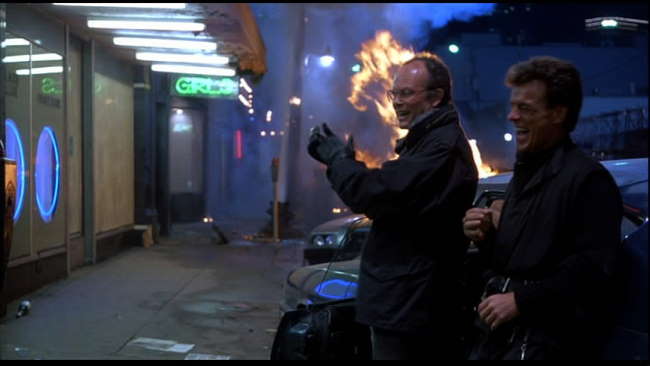
The Violence: Fair warning – Robocop is an extremely violent movie – so much so that upon its initial release, they had to cut two seconds of violence to prevent from receiving an “X” rating. Nothing is held back here, as Verhoeven continually strives for hyper-realism. We see limbs getting blown off, blood spattered faces and walls, and in-your-face gore of all varieties from beginning to end. However, the violence doesn’t stick out as a sore thumb – instead it serves to give the near-future city a nourish realism feel. In short, it works within the context of the narrative and surrounding visuals.
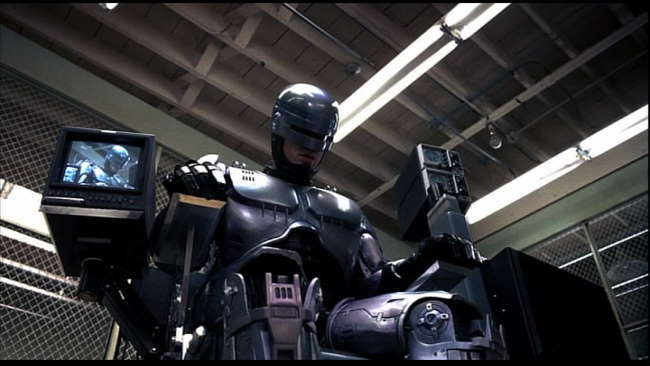
The FX and Set Designs: While Verhoeven gives us a somewhat futuristic city, he seems to err on the side of looking “normal.” We see this most clearly in the Ford Taurus police cars (which were brought in after everyone agreed the futuristic police car designs looked too tacky to be considered). However, the set designs are all wonderfully constructed, and all seem work well with one-another. The ED 209 looks terrific, and the stop-motion animation for it generally works. Robocop’s exterior design does look hoaky at first, but you eventually get used to it. On the other hand, Robocop without his helmet looks flat-out awesome.
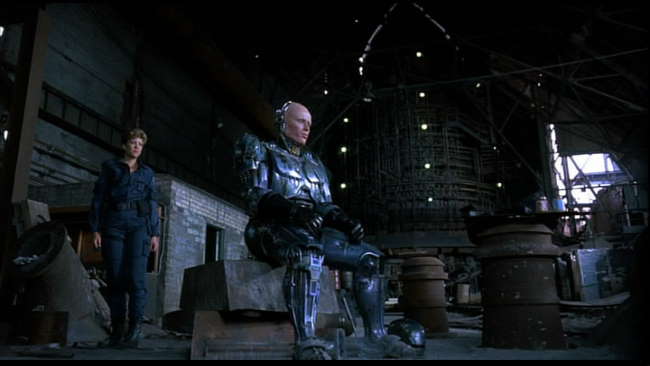
The Cyborg Questions: Robocop/Murphy give us a rich set of questions to ponder relating to cyborgs, the integration of programming with human minds, and in determining ownership after death.
- Cyborg and Humanity: As Murphy begins to realize who he was, and worse, what he’s become, the question asked is what degree of Murphy’s humanity remains? Murphy’s partner, Anne Lewis (played by Nancy Allen) serves to surface these concerns, as she still thinks that Murphy is inside somewhere. Yet, every aspect of humanity has been taken away from Robocop – he doesn’t have a home, but instead returns to a borg-like podchair at night to regenerate. Even if Robocop eventually considers himself human in some sense, it’s no longer clear what that even means. At best, Robocop is part of that strange category we call “post-human.”
- Man-machine interface – Robocop Style: Robocop gives us an interesting look at human brain-matter that has been fully integrated into a cybernetic body. Even more interesting though is the notion that external programming could limit the functioning of the human brain from controlling its new cyborg casing. If we think about it, this isn’t as far fetched as it may initially look: similar to how firewalls block “targeted” information from either entering or exiting a network, Robocop’s programming ensures the human mind adheres to the prime directives. But while the prevention part seems possible, the “directive” nature of the rules seems dubious, as does the erasing of his memory. These perhaps, are far harder to do without destroying the “cop experience” they so desired by picking Murphy in the first place.
- Dixie Flatline Construct Concerns: Similar to the Dixie Flatline Construct in Neuromancer, for all intents and purposes, Murphy is dead prior to being transformed into Robocop. At best we can consider him a zombie as his brain matter was re-animated after death. But like Dixie Flatline, he can think and perform sensemaking. Also like Dixie Flatline, he is limited by programming constraints. However, unlike Dixie Flatline, Robocop can still “feel.” So the question is this – if we develop the capability to re-animate someone’s consciousness after death, do they have the same basic human rights as they did when they were alive? Or are they the property of the corporation who revived them? Even weirder, could corpse’s estate executor (or spouse, for that matter) “sell” the corpse’s consciousness to a third party? If this is so, could your conscious be sold after the fact to pay off unpaid debts? Truly, the questions are mind-boggling!
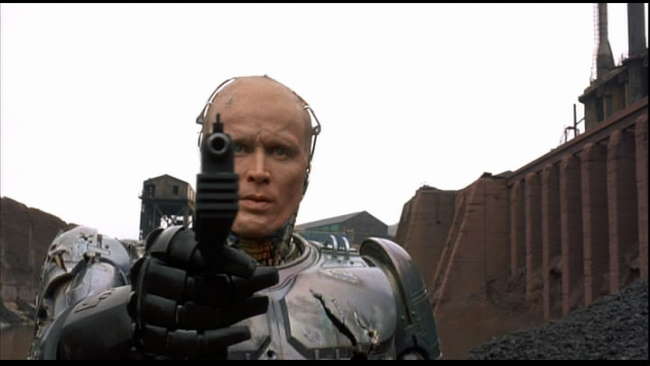
The Bottom Line: Robocop has to be considered one of the essential films of the cyberpunk genre. Some of the action scenes could have been better choreographed (a lot of the bad-guy deaths had the worthless storm trooper feel to them), but truly, the quibbles with this film are minor. Unlike the sequels, which largely come across as pathetic attempts to cash in on the original’s success, Robocop takes itself seriously from beginning to end. Because of this, it really does rise to something special. Even though Best Buy no longer considers Robocop worthy of carrying, don’t let this fool you – assuming you can stand the violence, Robocop deserves to be watched.
~See movies similar to this one~
Movie Review By: SFAM
Year: 1991
Directed by: Robert Rundle
Written by: Robert Rundle & Edward Sanchez
IMDB Reference
Degree of Cyberpunk Visuals: Low
Correlation to Cyberpunk Themes: Very Low
Key Cast Members:
Brent McCord: Lonnie Schuyler
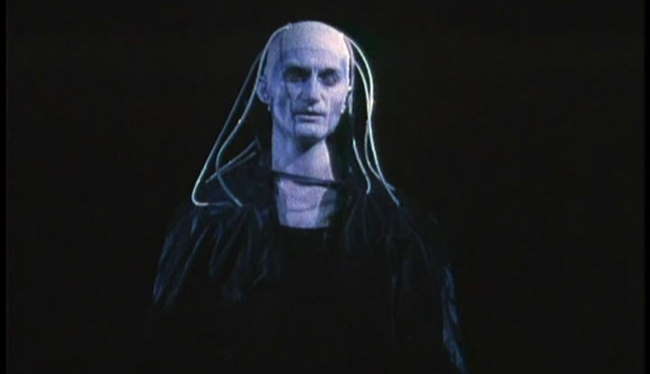
Overview: So you wanna make a cyberpunk movie but you don’t have any money, ey? No problem! As long as you have a hand-held video cam, some blue paint and a few extra malleable thin rubber tubes in your garage, you too can shoot your own cyberpunk movie! Fair warning - you might have to spring for a few bucks at Toys-R-Us for some realistic looking guns though, so try to save up a paycheck or two before getting started! Here we have an example of the lowest in cyberpunk cinema. My review will be slightly different than most in that I won’t bother hiding spoilers. Truly, you won’t care. If you watch this movie, you won’t be watching it in eager anticipation of the plot turns. While I do give Cybernator only 1 star, it really is one of those “so bad it’s good movies.” You really might be interested in dropping 6 bucks on this turkey. Think not? Read the review.
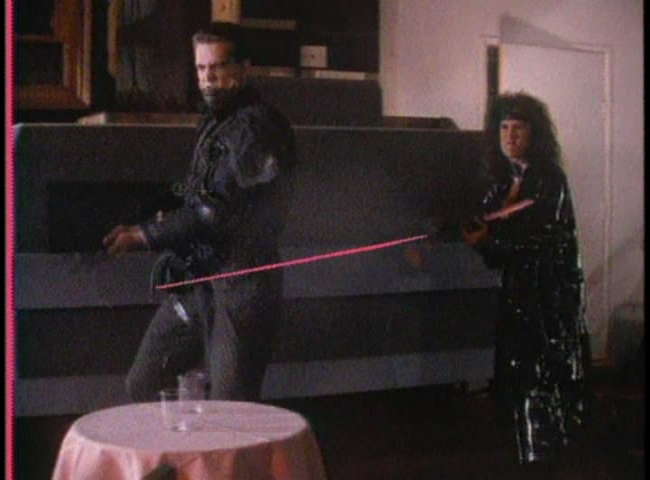
Notice the high-tech lasers! Apparently, they only had enough money to draw the pink part in twice, as its always one of two sizes. As another “feature,” whenever the laser fires, the left side of the screen has a nice pink line running down it.
The Story: The movie opens up in a complete dive strip club (a warehouse with a stage made up of black cardboard paper with shiny cut-out stars taped to it), where policeman Brent McCord (Lonnie Schuyler) comes along with his partner to see his stripper girlfriend. Unfortunately, some evil cyborgs have come to kill a US Senator, who just happens to be having sex in a sleazy room in the back (concrete walls, warehouse floor, etc.). After the evil cyborgs kill the senator, they decide to go on a rampage, randomly killing other folk. Of course, our great policeman is able to kill them, even though the cyborgs have ray guns.
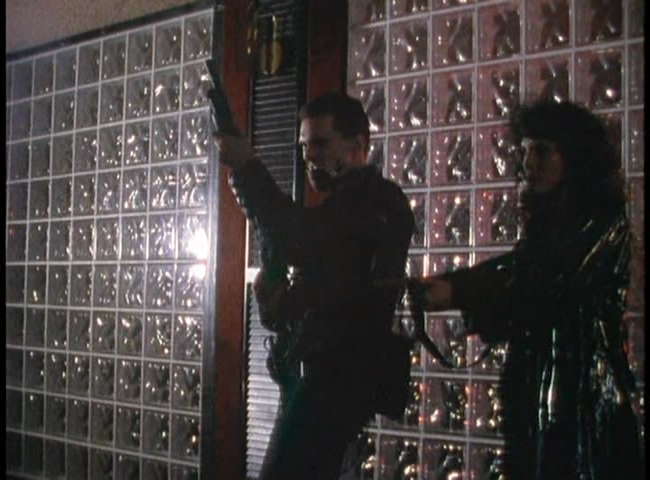
At the Morgue: the Morgue, which looks surprisingly like a made-up office room, has an Indian doctor (who actually appears to be trying to act - one of the few) who has just completed her autopsy on the two cyborgs. She states of the tough one, “He is covered with a steel titanium alloy…he is virtually indestructible. He was killed when the bullet entered the heart…”
Hmm…indestructible ey? But can be killed with a bullet through the heart? Hmmm….In any event, the morgue chick is apparently well versed in identifying military cyborgs, and proclaims that these ones are “government property, possibly from the army or something.”
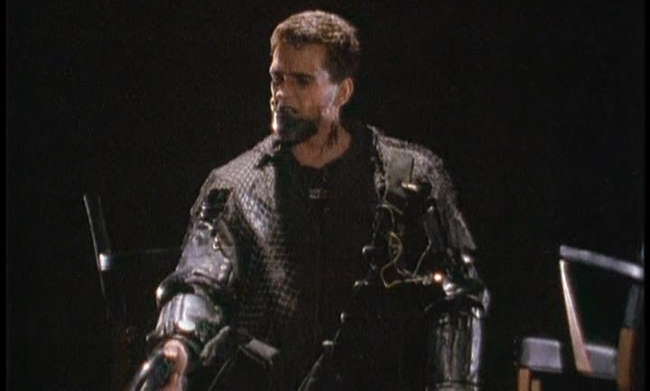
Indestructable! Unless, um, you shoot him in the heart, that is.
Our intrepid detectives then drive over to the local army building. You can tell its an army building due to the army-green colored early 70s oldsmobuick parked outside. They of course walk right into the General’s office, which is the same as the doctor’s office, but the bodies have been removed, and a flag and spaceman picture have been mounted on the wall. If this weren’t enough “reality” for you, the General’s desk has two American flags on it and a plastic toy tank to yet again convey that scary military feeling. This realism would have almost worked except for every so often, the camera veers too high and we see that the top of the general’s office is missing, and appears to be a made-up room in the same warehouse as the nudie bar.
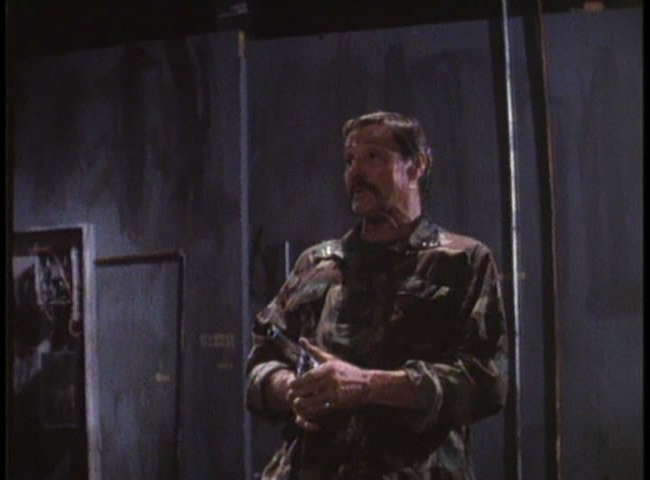
One of the few actual “B” movie actors.
In any event, while the cops are “interrogating” the general, (who tries to throw them off-track by proclaiming that the marines are working on that stuff, not the Army - so don’t bug him!), a random scientist walks in and announces, “Here’s the new design on the Blackhawk 2000 project.” After the General quickly kicks out the scientist, we find out that the Blackhawk 2000 project is “classified!”
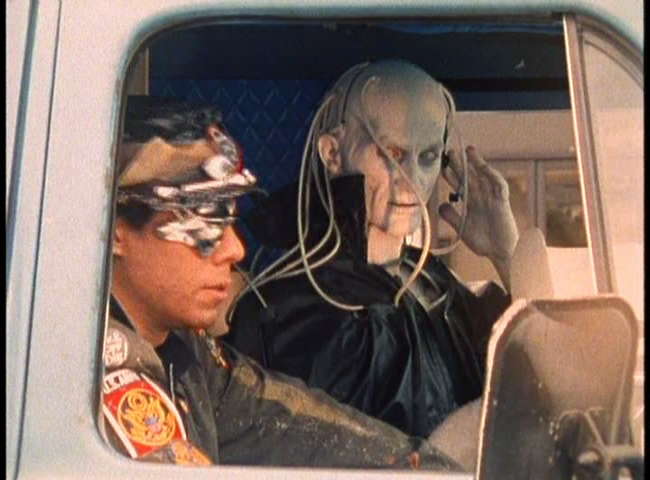
Here’s the cybernator again! Apparently, cyborgs in the future randomly gyrate from white to blue skin. I’m guessing they have “mood” skin.
Yes, ladies and gentleman, we have truly well thought-out plot points like this that permeate the movie. But wait - there’s more! That random scientist, who popped his head into the General’s office and spilled the classified program, quickly runs outside (like, RIGHT outside the General’s window) to secretly give the inside scoop to the cops. He of course wants to make sure they are really cops so he says, “You guys are cops? Show me your badges.” Being concerned that he’s meeting them right outside the General’s window, the scientist smartly tells them to meet him later that night in an abandoned alleyway. But alas, he was overheard by the Cybernator - who just happens to be waiting right next to them in a parked truck!
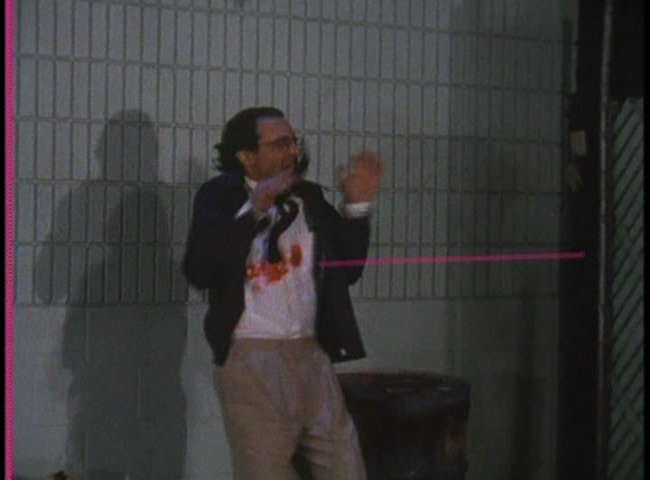
Interestingly, the laser shots don’t always arrive prior to the blood stains.
Unfortunately, our star’s partner gets killed by the Cybernator, so he decides to substitute his stripper girlfriend as his new partner. As the plot continues, we find that it is in fact an evil Colonel (played by an actual B actor - William Smith!) who is behind the nasty cyborgs. What’s worse, our dear police man is actually a cyborg in disguise!!!!! Versus us finding out by some cool way, say, of seeing the skin from his arm come off or something, they instead go for the ingenious method of just announcing it!
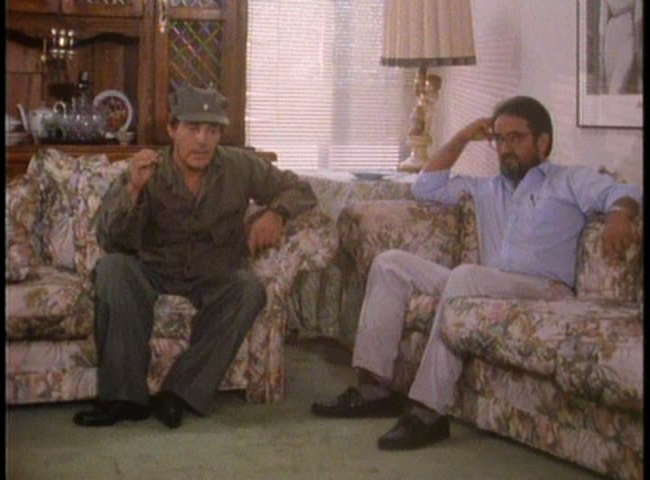
And now the military wants to kill the evil Colonel, so they capture the stripper and tell Brent that he’s a cyborg, and that he must kill the rogue cyborgs if he ever wants to see his stripper chick again. Are they guarding her at a special military base? Of course not! They appear to be holding the chick at the director’s house. Incidentally, I hope they added the puke green carpet to make us think this was an Army installation, cause if this was his actual decor, Damn!
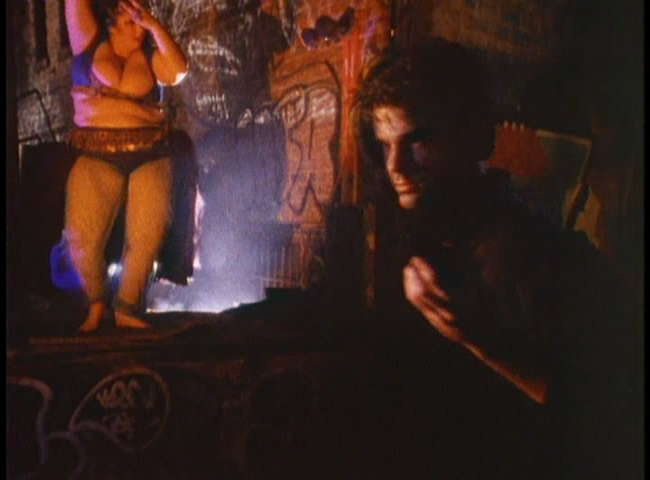
Apparently the heavy-set dancer in the street qualifies as the “underworld.”
Finally we come to the best scene of the movie - the fat cyberchick scene! This chick is doing her best at belly dancing, but apparently they forgot to give her lessons. Still, it’s the thought that counts, or so I’ve heard. I think this scene is supposed to represent the seedy underground - the place Brent goes to find out where the bad guys are. There’s nothing special here, but the line of the movie - it’s priceless.
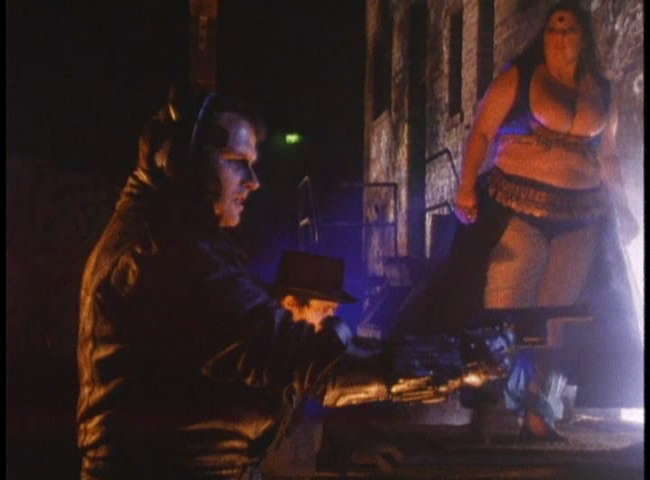
Ah yes, yet another random cyborg, enjoying the night delights.
A random sleaze bag dude is truly enjoying himself while watching the sexy belly dancer. Then he notices a cyborg standing nonchalantly beside him. Apparently, the cyborg doesn’t think she’s all that, which pisses off the sleazebag. So he, being a helpless, loser sleaze bag, of course decides to pick a fight, and says:
Sleaze bag: Cyborg Scum! You’ve got the passion of a toaster!
Cyborg Response: “Some of my best friends are toasters…You Fuck!!!”
The cyborg then takes out a gun and shoots the sleazebag in the face - definitely the best real laugh of the movie. 
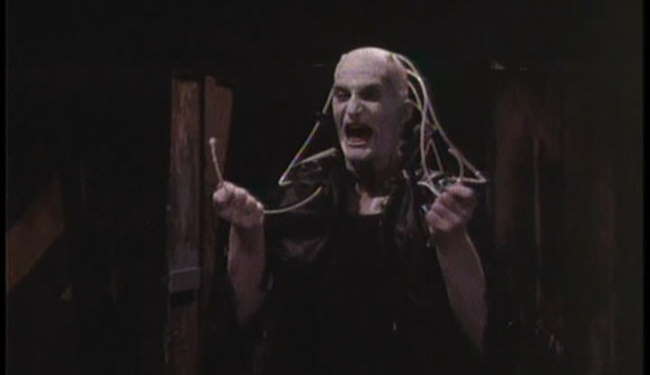
He’s almost indestructible…um, unless you rip out his rubber tubes, that is.
The movie goes on and on like this - until the final conflict! At last, we get to the epic battle between the two Blackhawk 2000 Cyborgs - the Cybernator and our cheesy cop detective, Brent. At least we’ll see an epic battle, right? NO!!! Yet again we are fooled. Guess how you beat the evil blue cyborg with the weird little tubes dangling from his head? That’s right - you just take out the tubes! True insanity in action ladies and gents.
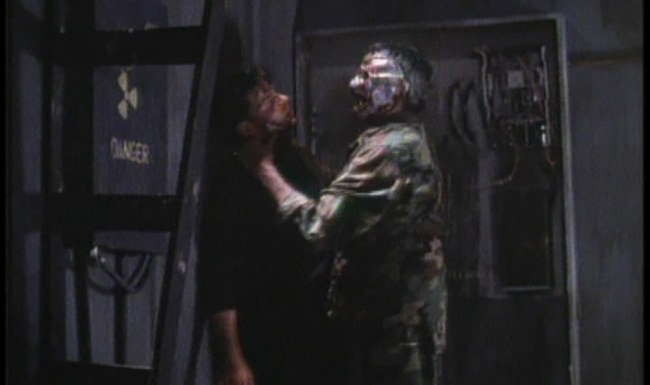
Yet another cyborg fight! Two for the price of one!
But wait! There’s more! It turns out that the evil Colonel Peck is…dun dun dun - Brent’s Brother!!!! Why the plot twist? No real reason given…just…um, because the Army is eeeeeeeevil! To which of course, Brent responds, “NOOOOOOOOOOOOOO” (not really…but he should have - instead he says, “Your not my fuckin brother!”)
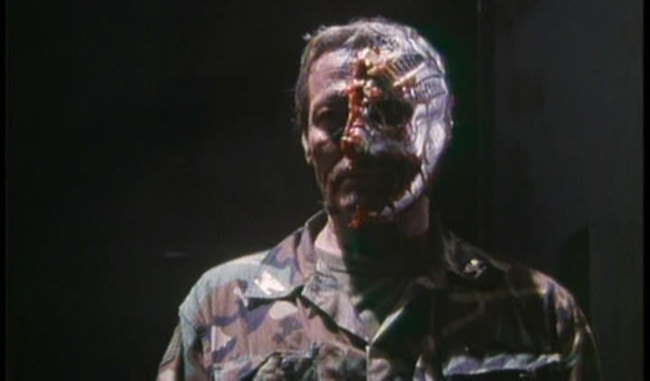
FYI - I think the gray spray-painted paper glued to the side of the colonel’s head is supposed to be his cyborg skeleton.
The Bottom Line: Now I won’t spoil it by showing you the cheesy ending, or worse, the cheesy rationale for the evil cyborgs, but suffice to say the quality is as good at the end as it is throughout. Rarely have I seen acting and dialog of this caliber. Clearly, the vast majority of the lines were ad-libbed (I hope). And, um, nobody in this movie can ad-lib. Still, Cybernator does qualify as a “So bad it’s good” movie – the type that makes Plan 9 look well thought out. So if you want to see the worst that cyberpunk cinema has to offer, kick back with a group of friends and enjoy!
~See movies similar to this one~
Movie Review By: SFAM
Year: 2004
Directed by: Alex Proyas
Written by: Jeff Vintar & Akiva Goldsman, based on book by Isaac Asimov
IMDB Reference
Degree of Cyberpunk Visuals: High
Correlation to Cyberpunk Themes: High
Key Cast Members:
Sonny: Alan Tudyk
Del Spooner: Will Smith
Susan Calvin: Bridget Moynahan
Dr. Alfred Lanning: James Cromwell
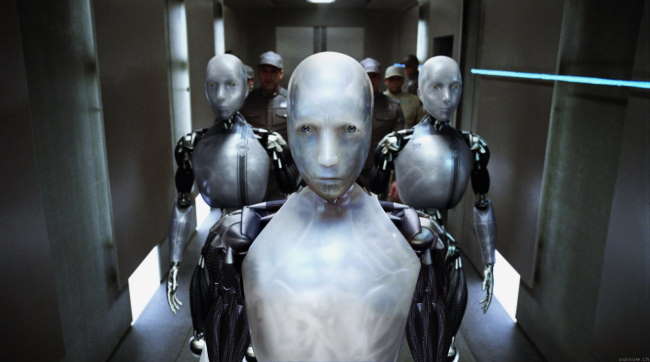
The Three Laws of Robotics
1. A robot may not injure a human being, or, through inaction, allow a human being to come to harm.
2. A robot must obey orders given it by human beings, except where such orders would conflict with the First Law.
3. A robot must protect its own existence as long as such protection does not conflict with the First or Second Law.
Overview: Superficially based on Asimov’s great collection of short stories - “I, Robot” – this movie of the same name usually sacrifices intelligent Sci-Fi for overblown summer blockbuster clichés. While Asimov fans will recognize the names of Dr. Alfred Lanning, Dr. Susan Calvin and Lawrence Robertson, they won’t recognize the characters that Proyas gives us. In yet another, “The evil robots are coming to control us” movie. I, Robot delivers eye-popping, often well over-the-top FX from beginning to end. Right at the beginning, I, Robot relays to us that they’ve set the bar low by spending the first five minutes delivering Converse Shoe and Fed-ex Delivery commercials. Still, I, Robot captures enough of the essence to make it enjoyable cyberpunk viewing. Asimov’s three rules are still in play here, and Sonny, the robot, actually makes it interesting.
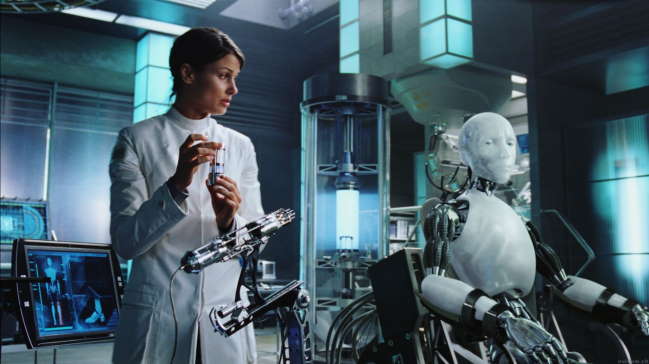
The Story: In the near future (2035), robots are a pervasive fact of life, and serve humans in a variety of capacities. US Robotics, maker of the fabled “NS” series of robots is just about ready to release their greatest innovation, the NS5 robots. NS5 robots are the most lifelike to date, and are destined to replace the ultra-reliable but outmoded NS4 model. The NS5s are guaranteed to stay new by receiving daily updates from US Robotics’s master AI system, “V.I.K.I.”
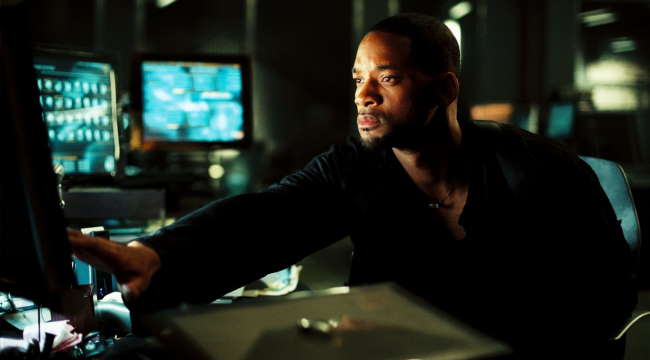
The week of the release, Dr. Alfred Lanning (James Cromwell), the founder of modern robotics dies in an apparent suicide. He leaves a clue behind for former patient and police officer Del Spooner (Will Smith). Del Spooner has reasons to hate and mistrust robots and immediately suspects foul play. US Robitics CEO Lawrence Robinson (Bruce Greenwood) is suspicious looking, and things just “feel” right.
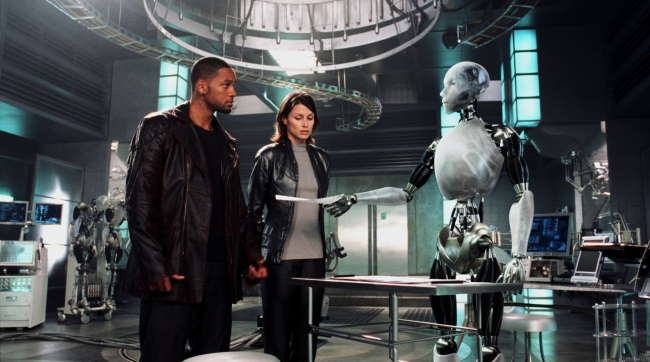
Assisted by robot psychologist, Dr. Susan Calvin (Bridget Moyanahan), Del finds an NS5 robot named Sonny, who appears to have freewill developed life-like features – so much that Del suspects Sonny of having killed Dr. Lanning. In following the breadcrumbs, Dels fears are realized – the robots do not seem to be adhering to the thee Laws of Robotics. Now they must race to uncover the real nature of the plot before the trap is sprung.
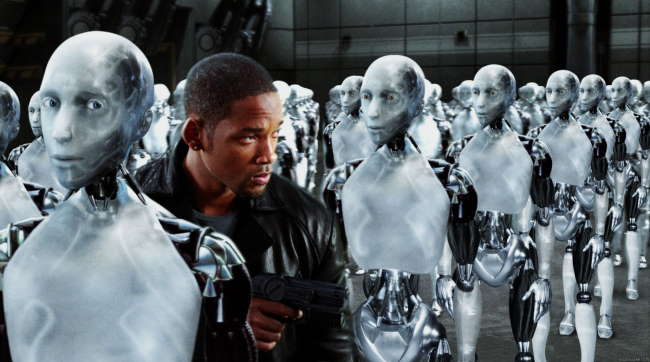
Will Smith Plays “Will Smith”…Again: You know the role – cocky, argumentative, underdog tough-guy cop – Be it MIB, ID4 or I, Robot, Will Smith plays the same old Will Smith. I, Robot was clearly green-lighted to bring in the teens to the seats over the summer – Will Smith is the guy to do this. Will Smith and massively cool FX = ROI. Unfortunately, it also engenders a far crappier story. Had we gotten an introspective no-name person in Smith’s role, we might have had a significantly higher degree of realism. But then again, realism would imply that things like the overblown US Robots Truck bashing scene wouldn’t have been included.
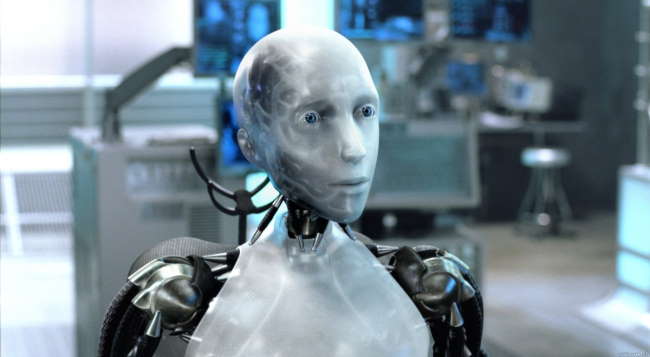
Sonny: If not for Sonny, I, Robot would be almost unwatchable. Sonny (voiced by Serenity star, Alex Tudyk) provides us an investigation into android humanity similar to Star Trek’s Data in his better moments. While some of it comes off as sappy, Sonny’s questioning of his right to exist, and more interestingly, his hopes that others consider him a being instead of an it provide the best moments of the movie. One can only wonder how much better I, Robot would have been if this aspect of the movie was highlighted vice the focus on Will Smith and the overblown FX scenes.
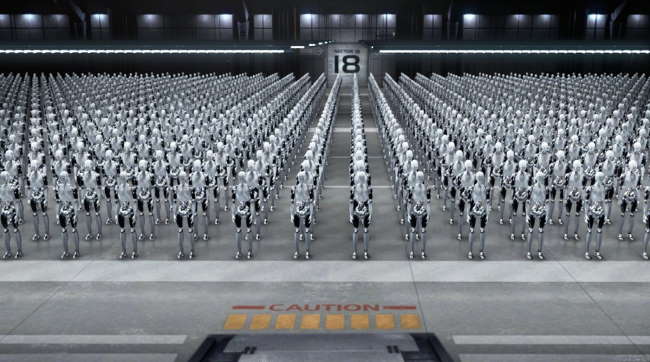
“There have always been ghosts in the machine – random segments of code that have grouped together to form unexpected protocols. Unanticipated, these free radicals engender questions of free will, creativity, and even the nature of what we might call the soul. Why is it that when some robots are left in the dark they will seek the light? Why is it that when robots are stored in an empty space they will group together rather than stand alone? How do we explain this behavior? Random segments of code? Or is it something more? When does a perceptual schematic become consciousness? When does a difference engine become the search for truth? When does a personality simulation become the bitter moat of the soul?”
Evolution of The Three Laws: I, Robot touches on some interesting questions concerning the three laws. If, taken to their logical extreme, do the laws imply, similar to Colossus: The Forbin Project, that machines should consider removing our freewill in order to protect us? Also, given a set of operating conditions that include the ability to learn from the environment, are we truly sure that machines would not eventually develop sentience and freewill? This is especially problematic when science has yet to deliver a definitive statement on how this comes about.

The FX: Yes, I, Robot delivers awesome android FX – continually so, in fact. The mandatory overblown chase scenes, massive explosions and lots of gun fighting are all there, but so are the robots. And the robots are simply amazing. Their facial expressions are lifelike, their exoskeleton muscles look believable, and their demeanor seems perfect. However, their cartoon-like ability to jump as high and far as they like is well past over-the-top. Worse, not all of the NS5s are equal, as near the end they transform into bumbling fools, where an army of them seems unable to stop two humans in possession of guns that never run out of ammo.
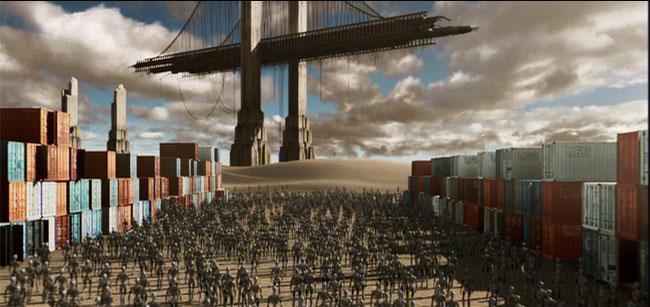
The Bottom Line: One wonders how great I, Robot could have become had the studios given Dark City director Proyas more of a free hand in its development. Instead, I, Robot is a summer blockbuster first, and an interesting cyberpunk movie second. Still, Sonny and the robot FX raises I, Robot to be more interesting and enjoyable than it has rights to be. The performances of the leads are pretty much all lackluster – make no mistake – Sonny is the star here, and dominates the screen during every appearance he makes. Normally I give overblown summer blockbusters with great FX five or six stars – Sonny, and the wonderful ending visual makes I, Robot deserve a bonus star.
~See movies similar to this one~
Year: 1989
Directed by: Albert Pyun
Written by: Kitty Chalmers
IMDB Reference
Degree of Cyberpunk Visuals: Low
Correlation to Cyberpunk Themes: Low
Key Cast Members:
Gibson Rickenbacker: Jean-Claude Van Damme
Nady Simmons: Deborah Richter
Fender Tremolo: Vincent Klyn
Pearl Prophet: Dayle Haddon
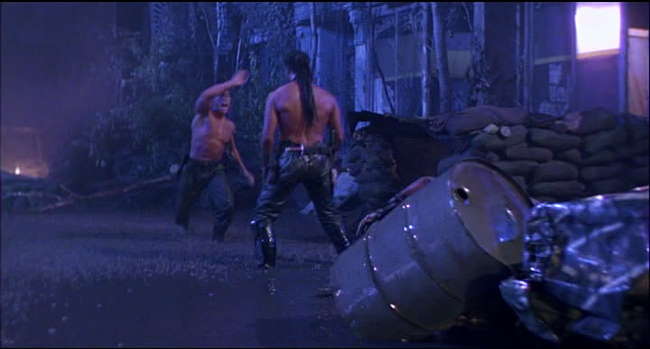
Overview: OK, so you have Jean-Claude Van Damme – a guy that can’t show any emotions other than staring intensely or screaming anger – but at least he’s an awesome fighter. So all you have to do is provide a simple, semi-coherent story that allows the guy to show his two emotions and then spend the rest of the movie kicking ass. Simple, right? Unfortunately, Pyun’s Cyborg fails miserably in the story department. From beginning to end, the rationale for key events are completely non-sensical, which leaves us a steaming pile of crap with pretty good fight scenes.
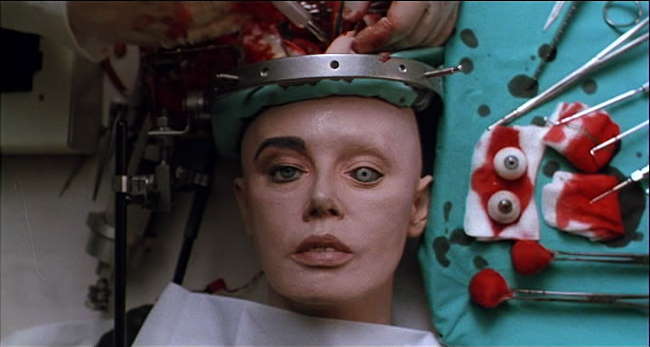
The Story: In a bizarre dystopic future that has ultimate anarchy next to people apparently trying to build little houses on the prairie, a modern version of the plague has devastated an already crippled society. But a cure has been found. And for some reason, these people in one location need to get the cure from another location before it can be used. So…the answer to make this happen is to take one of their hot chick key engineers named Pearl Prophet(played by Dayle Hadden) and TURN HER INTO A CYBORG!!! Why the fuck do they turn her into a cyborg in order to play courier, you ask? Does this make her impervious to attacks? No…in fact, she’s completely worthless as far as combat is concerned. In fact, absolutely NO reason is given for this transformation. We are left to assume that somehow, hard drives only work in the future if they are embedded in people’s bodies (there is a focus on her cybernetic eyes, so perhaps they want us to believe that optical cameras only work in the future if embedded in cyborg eyes). Nor do we find out why the cure will be lost if this cyborg chick dies (gee – if this is a Johnny Mnemonic type thing, can’t they just upload it in chick #2?). In any event, her guardian is killed by the “flesh pirates” and now she needs another body guard. It just turns out that Jean-Claude Van Damme, hero extraordinaire’s one happy family moment was crushed by the flesh pirates, so he’s more than happy to go to the rescue. And for some reason, he’s taken a straggler, Deborah Richter, for the ride.
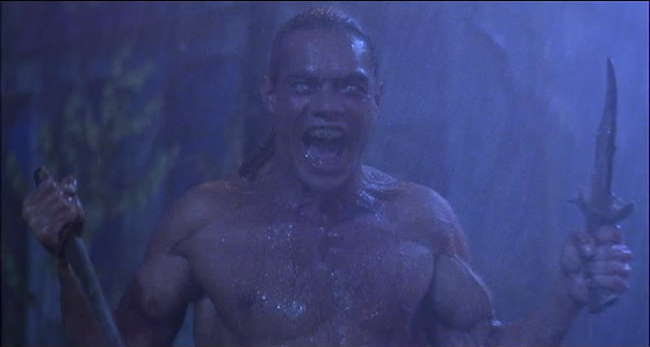
The rest of the movie is a tracking/confrontation movie where Van Damme tracks down Vincent Klyn, leader of the flesh pirates and engages them in fight after fight. Not surprisingly, Van Damme initially gets his ass beat a few times before we get to the predictable ending. In keeping with the whole incoherence theme, in one scene Van Damme is crucified on a ship’s mast (with nails through the hands – the whole bit), but is fully healed by the next evening’s final showdown. Even worse, we find out from Pearl Prophet, the cyborg chick, that her homies back at the fort can kill the pirates anyways, so we are left wondering why Van Damme even bothers.
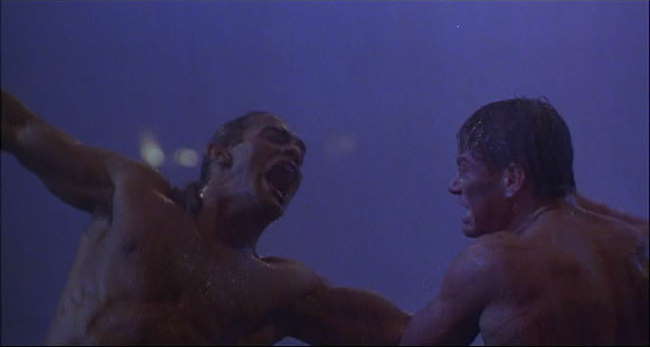
The Bottom Line: The whole goal of the movie was to get Van Damme going at it with buff surfer Vincent Klyn. Why they even bothered to add a cyborg to this is beyond me, as it simply doesn’t fit with the story. Who knows, maybe this was the only thing they had available in their limited FX bag. Well, cool, why not spend the 20 minutes it takes to actually write a rationale for the cyborg’s inclusion? In short, this film was never going to be great, but with a little amount of coherence, it could have been decent. I do give one star extra for the fight scenes, which gives Cyborg 4 stars.
~See movies similar to this one~
Year: 1999
Directed by: Andy & Larry Wachowski
Written by: Andy & Larry Wachowski
IMDB Reference
Degree of Cyberpunk Visuals: Very High
Correlation to Cyberpunk Themes: Very High
Key Cast Members:
Neo: Keanu Reeves
Trinity: Carrie-Anne Moss
Morpheus: Laurence Fishburne
Agent Smith: Hugo Weaving
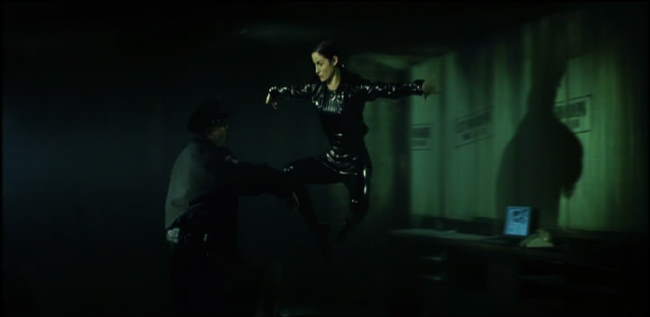
Definitely my favorite opening sequence of all time. Just a great great start to a movie!
Overview: The Matrix is one of my all-time favorite movies, so I’m just not going to attempt to come off as unbiased about it. Additionally, I’m guessing that pretty much everyone who’s coming to this site has seen it - probably numerous times, so I’m guessing a plot description isn’t of much value here. In short, my conundrum with the review is this - what should I say about this movie that will in any way add value to the reader? Answer: Not much. Instead I have decided to keep the bulk of my comments for various essays on the Matrix Trilogy.
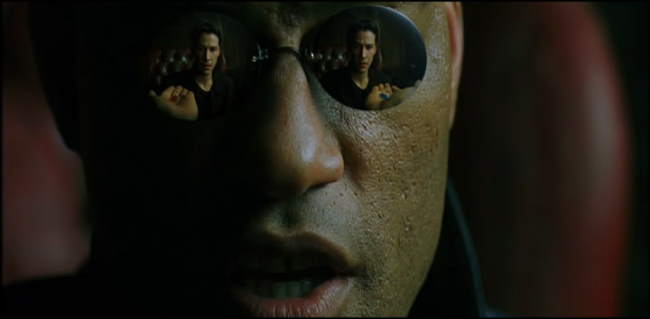
Matrix Influences: The Matrix influenced movies in general and society as a whole. With respect to movies, we see numerous influences, including:
- Special Effects: Bullet time and a myriad of other FX are now standard practice in movies and commercials
- Synonymous with “Cool”: Movies that have a “matrix-like” feel are advertised all the time. We know what this means - it means they aspire to be ultra-sleek, ultra-cool and the “in” thing.
- Fight Sequences: By hiring Hong Kong Martial Arts master Yuen Wo-Ping to coordinate the fights, the Matrix raised the bar on mainstream American movie fight sequences
- Matrix Source Code: The Matrix source code, taken in part from Ghost in the Shell, is everywhere now, and is instantly recognized, as is its meaning
- Hot Chicks in Black Shiny Stuff Kicking Butt: Trinity’s influence has massively upped the anty on action chicks in movies. While Michelle Pfeiffer’s Catwoman in Batman Returns re-initiated this trend, Carrie Anne Moss’ Trinity has made this outfit almost mandatory for female action heroines.
- The use of philosophy in movies: The Matrix seems to have broken the barrier to discussing philosphy in movies. Lets hope this idea lives on.
- Fashion: From Sunglasses, to overcoats to cyberpunkwear, the Matrix has changed the way people dress.
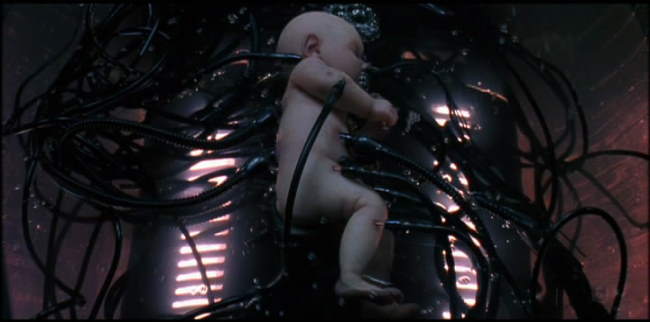
The Bottom Line: The Matrix is already one of the most influential in science fiction, and is truly one of the cornerstone cyberpunk movies in existence. We get it all here: terrific action, awesome cyberpunk concepts, incredible cyberpunk visuals, cool philosophical discussions, an absolutely awesome soundtrack (although DoomAng3l disagrees with this - see his comment below) and innovative FX. On top of this, all the leads were terrific. Reeves makes a perfect Neo, and Moss, Fishburne and Weaving give career-defining performances. Look below for move screencaps on page 2, and additional essays on the Matrix.
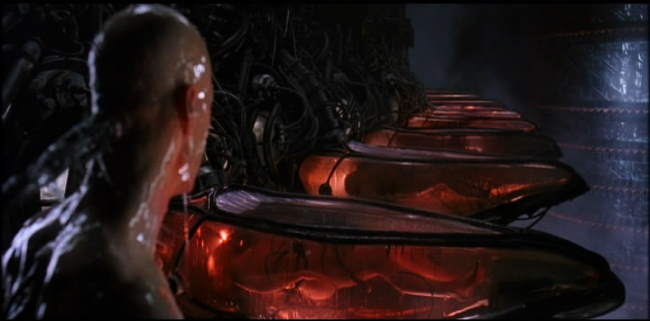
Matrix Essays
- The Matrix Trilogy: A Man-Machine Interface Perspective: This essay explores the Matrix Trilogy specifically from a scifi perspective - the purpose of which is to show how Neo’s journey is really a sequel to Motoko’s transformation at the end of Ghost in the Shell. Developed throughout the trilogy, Neo becomes a fully merged entity comprised of a sentient program with a human.
Page 2: More Screencaps–>>
~See movies similar to this one~
Year: 1993
Directed by: Hiroshi Fukutomi
Written by: Yukito Kishiro (Manga), Akinori Endo
IMDB Reference
Degree of Cyberpunk Visuals: High
Correlation to Cyberpunk Themes: Very High
Key Cast Members:
Gally (Alita): Miki Itô
Ido: Kariya Shunsuke
Yugo: Kappei Yamaguchi
Chiren: Mami Koyama
Vector: Shigeru Chiba
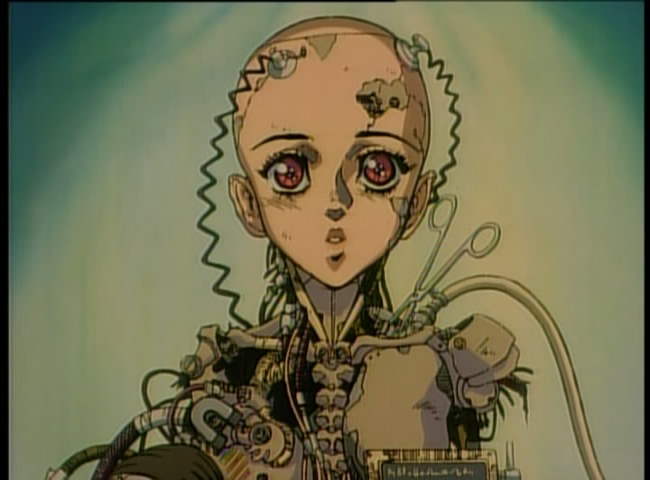
Overview: Battle Angel is based off a very well done Manga series called Battle Angel Alita. The movie covers the first two volumes of the Manga: Rusty Angel, which documents Alita’s “rebirth” and Tears of an Angel, which portrays a tragic love story. This anime from 1993 is one of the best man-machine interface animes out. The story is solid, and the drawing for that time period is terrific. While you might hear some gripe that the Manga is better, I think Fukutomi did a terrific job in taking Kishiro’s story to anime. I can only hope that James Cameron does a similarly wonderful job with the upcoming live action version of this. Just a warning - this is not a kids story - it contains lots of blood, head removals and minor amounts of nudity.
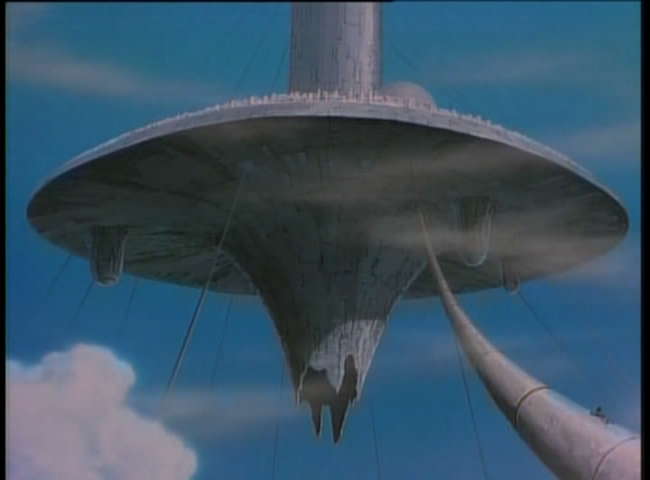
The Setting: Battle Angel takes place far into the future, after a societal collapse has occurred. Advanced human society has been relegated to a floating city called Zalem, that sits above a refuse heap called Scrap Iron City, which is inhabited by denizens living off the scraps and waste products Zalem expels. A corporation called the “Factory,” the primary employer for Scrap Iron City, sends products back up to Zalem through a series of huge metal tubes. Cyborg technology has become a way of life, with many “humans” having only their brain remaining from their original human body host. Scavenging and theft has become a way of life for many. Backbones are a particularly sought after commodity by thieves, who sometimes will violently take them from their living hosts. As social services no longer exist, the Factory posts “bounties” for the heads of the most egregious villians, which bounty hunters, called Hunter-Warriors pursue for money.
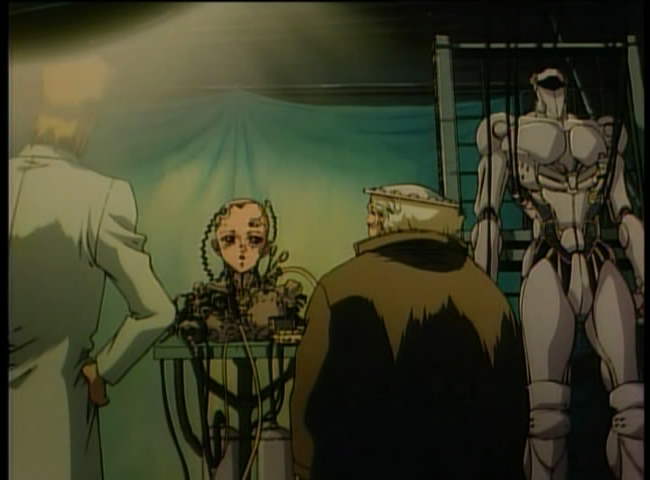
Rusty Angel: Daisuke Ido, an cyborg doctor extraordinaire, former citizen of Zalem, scavenges through the refuse heap to find spare cyborg parts to repair the citizens of Scrap Iron City. One day he comes across a female cyborg head that has a still-living human brain in it. He sets out to repair this head and gives her a wonderful body off of parts he has collected. He names her Gally (she is called Alita in the Manga), and she seems totally restored, except for the loss of memory from her earlier life. Ido becomes attached to Gally and they quickly develop a father-daughter type relationship.
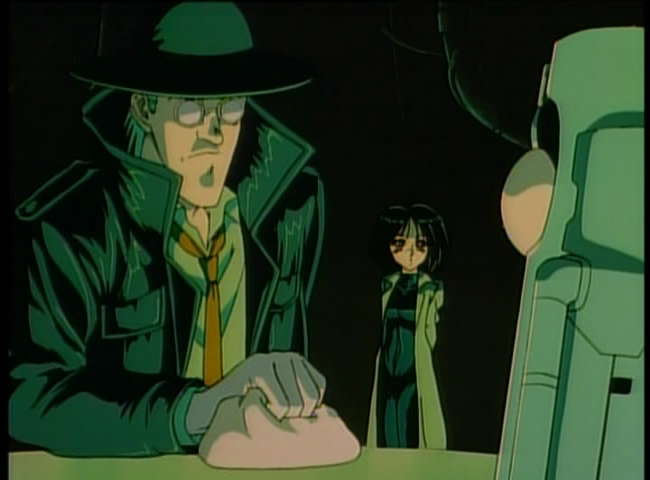
Gally learns that Ido moonlights also a Hunter-Warrior both for moral reasons and to support his medical practice. Gally saves Ido from certain death, and thus, reveals that she, in her former life, was also a very talented warrior. Under protest from Ido, Gally asserts her individuality and desire to become a Hunter-Warrior like Ido, so that she too can have purpose to her life.
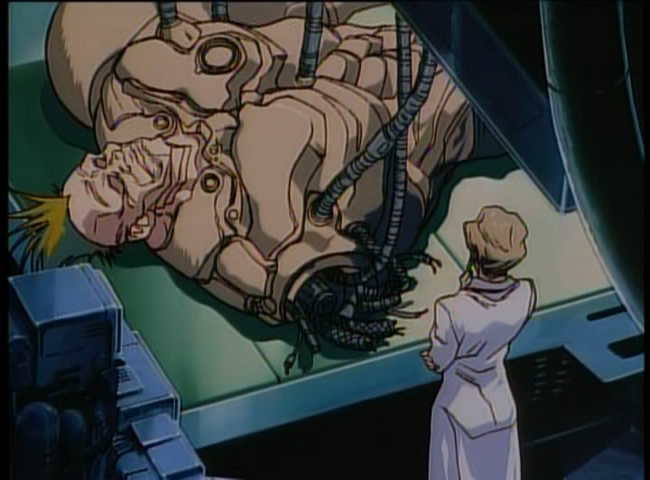
Chiren, also a cyborg doctor and Ido’s former partner, has also been ousted from Zalem, and is consumed with finding a way to return. Deciding that she will do anything to make this happen, Chiren hooks up with Vector, a shady character who has connections with the “Factory,” who agrees to eventually take her to Zalem in return for sexual favors and for her assistance in building a supra-cyborg gladiator named Greweicia for the fighting ring. This cyborg warrior also has a penchant for eating brains, and ends up on the bounty list. Chiren, wanting to be seen as superior to Ido, gets Greweicia to fight Gally in the hopes of destroying her, and thus, destroying Ido.
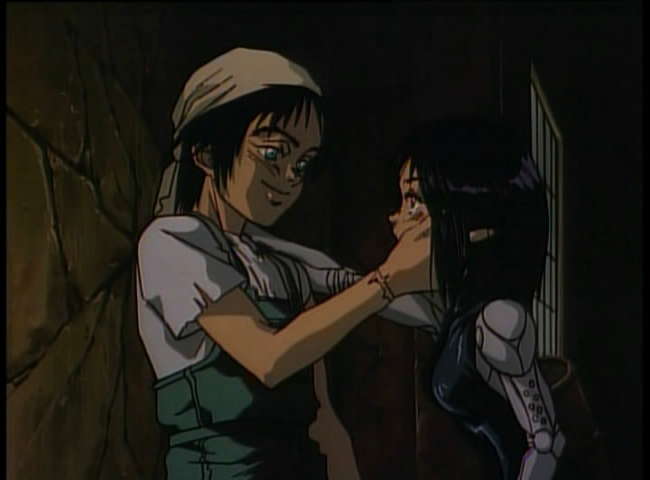
Tears of an Angel: Gally, in exploring the city has become infatuated with a hard working body named Yugo, who dreams of going to Zalem. Although it’s common knowledge that nobody born in Scrap Iron City can ever go to Zalem, Yogo is also consumed with finding a way, and has gotten an agreement from Vector, who promises Yugo if he can make 10,000,000 credits, than he will take Yugo to Zalem. Yugo has taken him up on his offer and has started stealing cyborg spinal cords as a way to augment his day job of fixing machinery. He is discovered, and is put on the Bounty list. Gally, who has fallen deeply in love with him, tries to rescue him from a rival bounty hunter. Unfortunately she is too late, but is able to save his head, and asks Ido to turn him into a cyborg. Even after becoming a cyborg, Yugo’s dreams of reaching Zalem cannot be abated, as he sees his life a struggle against the worthlessness that is the Scap Iron City.
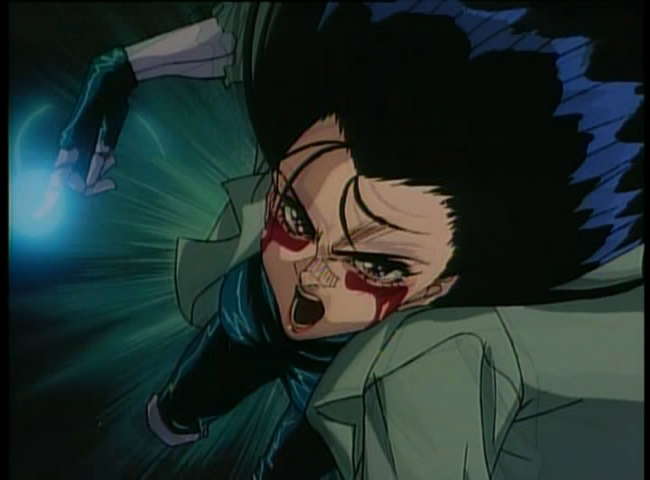
The Artwork: In Battle Angel, we see strong influences of Akira in most every aspect of the production. From the facial expressions to the darkly textured backgrounds to the fighting style approach, Battle Angel clearly has used Akira as a template for modern animation techniques. Like many OAVs of this time period, some of the backgrounds are bland while others are lavishly penned and inked with multi-layered designs. They “pick their battles” with the designs, but for the most part, the decisions are solid. The simple designs are in backgrounds such as the sky and in Ido’s house. The more complex ones are in the underground, Yugo’s hang out, and in the refuse heap scenes – this is where most of the action and plot take place.
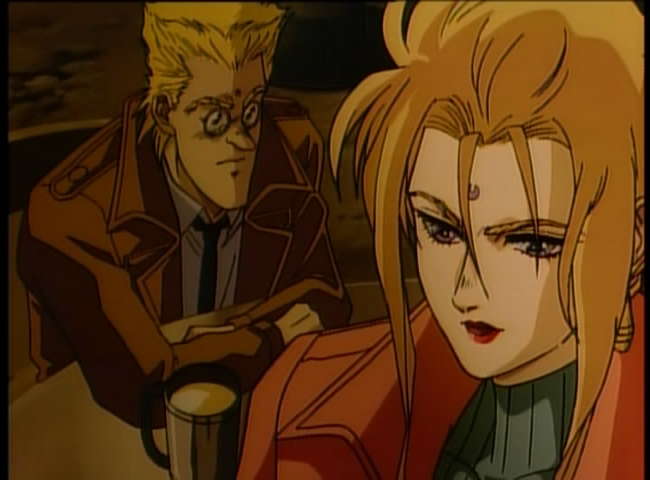
Changes from the Manga: While I think Battle Angel is a terrific anime, there are some changes from the Manga that some find annoying. Most bizarre is the renaming of Alita to Gally, and the city Tiphares to Zalem. However, unlike some, I don’t find the changes in the plot to be that problematic. The anime wonderfully captures the essence of the Manga. Perhaps the biggest change is the rationale for Alita’s powers. In the anime, we really don’t get an explanation, but in the Manga, Alita is first given a normal body by Ido, and ends up destroying it in her first fight. Realizing that Alita is a warrior at heart, Ido gives her the body he has saved for a long time – that of a berserker warrior. The primary villain in Rusty Angel is also different – he is a being who has grown up in the sewers, and after losing his body in fighting Alita, he takes over the Gladiator’s body. And Chiren, a central character in the anime is not in the first to novels of the Manga. Again, for the most part, I have no problems with the changes, and actually love the dimension that Chiren adds.

The Bottom Line: Battle Angel (Alita) just works for me as an anime. It is intelligent enough and well enough executed to get you to imagine a world where cyborgs are a reality. The world from the underground perspective is well done and Alita (I call her Alita, not Gally) as a character is terrific. Along with Armitage III and Ghost in the Shell (obviously), Alita is one of the best animes of this kind. Just a caution for those who have only seen the VHS, like most Japanese animes, Battle Angel comes off FAR FAR better with the Japanese dubbing cast than it does the English cast.
~See movies similar to this one~
Year: 1992
Directed by: Shinya Tsukamoto
Written by: Shinya Tsukamoto
IMDB Reference
Degree of Cyberpunk Visuals: High
Correlation to Cyberpunk Themes: Medium
Key Cast Members:
Taniguchi Tomoo: Tomorowo Taguchi

Overview: Unlike the tagline (should not be missed…), I think its quite OK to miss Tetsuo II, especially if you’ve already seen the real thing. In Tetsuo II, Tsukamoto substitutes a larger budget in lieu of the unique and innovative narrative we find in Tetsuo - the Iron Man. The compromise is bad all around. For starters, this style of merging man and machine works FAR better in B&W than it does in color. The surreal believability factor of the FX drops significantly in color. As for the story, the whole idea of centering the conflict around a family setting significantly lessens the power of his earlier story, as does Tsukamoto’s attempt to add a more coherent narrative. While his point still seems to be the same one, its told with lots less force, in a far less interesting way, and also in a far less shocking way.
The Bottom Line: I can take screencaps of this if anyone is dying to see the visuals (I understand it’s out of print), but it’s just not a great movie. Tetsuo: Bodyhammer is OK to see this as long as you understand you’re getting a Japanese Cyberpunk movies that’s far less than Tetsuo - Iron Man, or even less than Rubber’s Lover, for that matter. I’ve heard people comment that Bodyhammer sucks so they aren’t interested in seeing the first one - don’t buy this reasoning. While the first screams uniqueness, Body Hammer whimpers “cash in on my earlier success by cutting back the edginess and going more mainstream.” It even stars Tomorowo Taguchi again, who attempts to reprise the same role and crazed scream faces - only this time it comes across more as the last show in a long day of staged repeat performances, similar to what you might find in a theater act at an amusement park late on a Sunday evening. In that sense, Body Hammer comes off as a sequel in true hollywood style.
~See movies similar to this one~
Year: 1988
Directed by: Kazuhito Kuramoto
Written by: Kazuhito Kuramoto
IMDB Reference
Degree of Cyberpunk Visuals: Medium
Correlation to Cyberpunk Themes: Medium
Key Cast Members:
Dwarf Scientist: Toshihiko Hino
Scientist’s dying sister: Mio Takaki
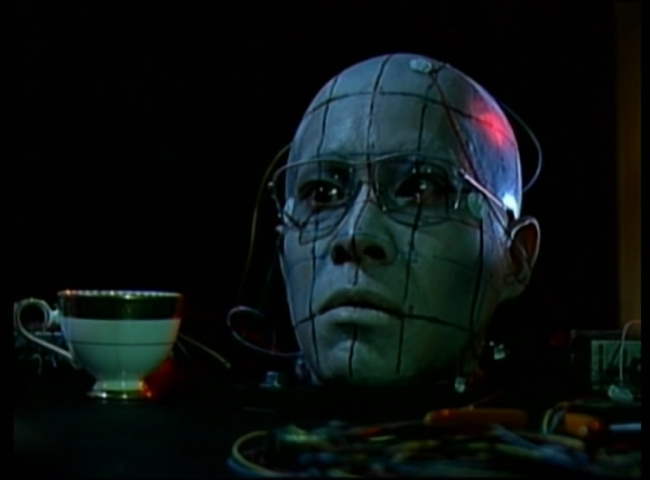
Overview: Japanese Cyberpunk films are always looking to extend the boundaries of humanity, but hopefully they do so within the constraints of a semi-coherent plot, with actions by the characters that make sense within the twisted view of the narrative. Android of Notre Dame does away with most of that, and instead goes for massive gross-out scenes with characters whose actions rarely make sense. Gooey substances of all colors and textures come spewing out of every crevice possible from this head in the above shot.
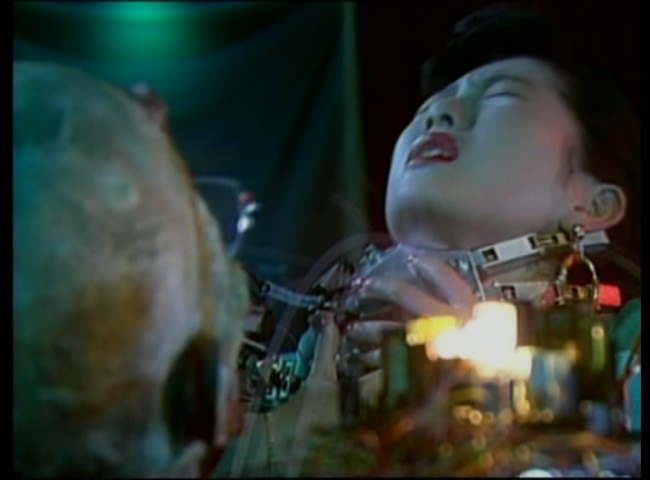
This story, such as it is, has a Japanese dwarf scientist playing a modern-day Dr. Frankenstein (well, Dr. Frankenstein as the hunchback of Notre Dame, actually) in an attempt to find a way to prolong his dying sister’s life. Yet, instead of going to the morgue, he goes out and finds associates, kills them in gruesome ways and then performs experiments on their various body parts. His most successful one is shown in the picture at the top, where he takes a guy’s head and hooks him up to a variety of wires and implants that allow the “android” (or really, we would call this a cyborg) to have facial movements, control a robotic arm and also can record his visual perceptions into a television. He also has his cyborg head kill this other chick so he can remove her heart in an attempt to fix his dying sister’s heart.
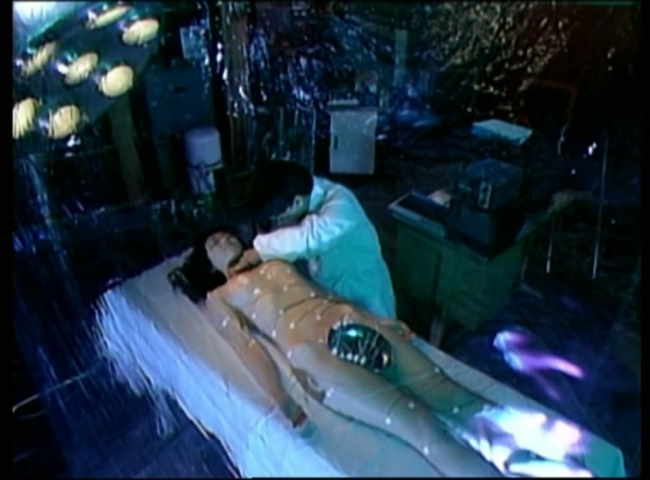
Image modified to obfuscate nudity. Go here if interested in seeing the unmodified image.
The Bottom Line: The idea behind Android of Notre Dame is rich, and, had it been executed better, might have yielded a pretty good Japanese Cyberpunk Flick. The ending scene in particular, where we see the scientist’s final failed solution is especially intriguing. Unfortunately, it seems that the Kuramoto was more interested in capturing gross-out scenes than he was in pursuing a promising, if limited story line.
~See movies similar to this one~
Year: 1995
Directed by: Albert Pyun
Written by: Albert Pyun (story and screenplay), Christopher Borkgren (screenplay)
IMDB Reference
Degree of Cyberpunk Visuals: Very Low
Correlation to Cyberpunk Themes: Low
Key Cast Members:
Chance O’Brien: Keith Cooke
Jo: Tina Cote
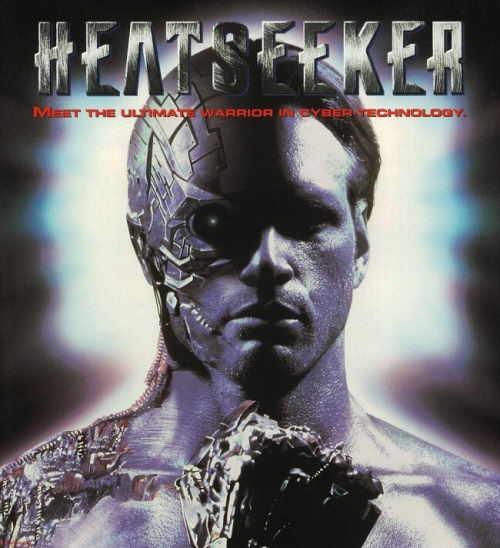
Overview: This has to qualify as one of the most misleading promotional photos ever. This movie has NONE of those cool cyborg stuff in it. Heatseeker is a low budget martial arts tournament fight movie wrapped in a cocoon of cheesy dialogue that calls the fighters cyborgs - but there is pretty much NO visuals to that effect. In this movie which takes place in the near-future, where cyber-corporations, emeshed in a global competition to be the leader in cyber technology have devised a martial arts tournament to see who has the best cyber-equipment. Chance O’Brian (played by Keith Cooke) is the martial arts champion of the world, and is going to marry his trainer, Jo (played by Tina Cote). Some evil, nasty, mean, rotten (did I get the point across) cyber corporation types abduct his wife and force him to fight in a tournament of cyborg fighters to give the fight legitimacy. Also, Jo has to have sex and train the evil, nasty, powerful, mean and rotten cyber-corporation’s champion, who just happens to be Chance’s chief rival. The tournament goes on, but I think you can pretty much guess how this goes.
The Bottom Line: From a story perspective, Heatseeker doesn’t even make an attempt to be anything but a low-priced piece of crap. The acting is downright horrid in places and the characters are the epitome of one dimensional. The only redeeming value in this are the fight sequences, which are usually decent. For this reason, I give it an extra star for the fight sequences, but I take one away for the misleading promotional picture, and another away from the completely non-believable ending sequence.
~See movies similar to this one~
Year: 2004
Directed by: Jeff Renfroe & Marteinn Thorsson
Written by: Jeff Renfroe & Marteinn Thorsson
IMDB Reference
Degree of Cyberpunk Visuals: Medium
Correlation to Cyberpunk Themes: Very High
Key Cast Members:
Simon J.: Jeremy Sisto
Derrick: Udo Kier
Howard: Lance Henriksen
Trish: Deborah Kara Unger
The Neighbour: Bruce Payne
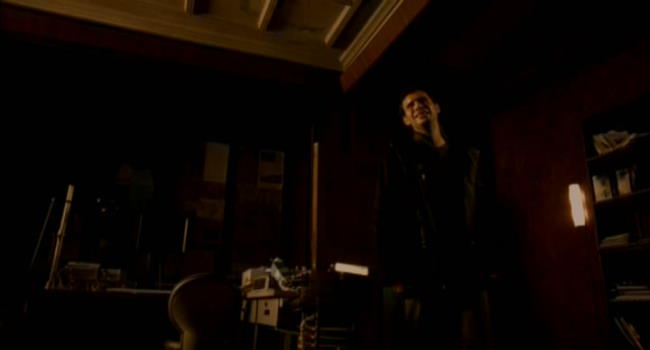
There are good people and there are bad people and they’re on their way,
and they want you, Simon…
The bad people can save you, but they won’t…
The good people want to save you but they can’t…
Overview: Every now and then I run across an absolutely extraordinary cyberpunk film, largely forgotten or ignored by the film going masses. More often than not, this film is foreign and never had a decent release in the US (where I’m from). One Point O (called Paranoia 1.0 in the US) is European a film that meets these criteria. Truly, you’ll be hard pressed to come close to finding an immersive film as One Point O. When you consider this was reportedly shot and produced on a budget of 1.7 Million, you begin to understand the enormity of what was accomplished here. No, you don’t get cool explosions or guns, or fancy CG effects, but you do get an absolutely awesome near-future dystopic story with a biting commentary on advertising and software development, all wrapped up in an extremely immersive, slow paced film. Everything is subordinated to the mood here, which is emphasized by the color choices and simple score. Unfortunately, I will need to be pretty vague in this review, as the ending definitely has a Sixth Sense type feel to it.
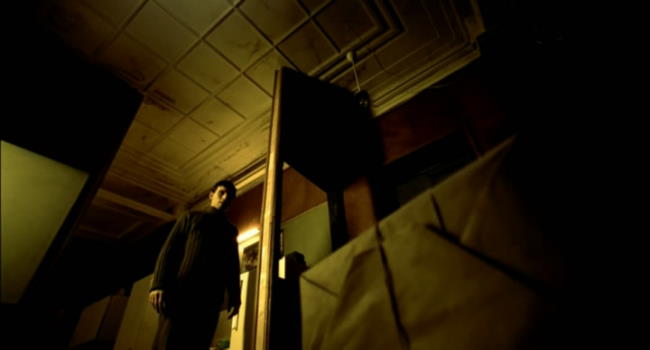
One Point O is about a computer programmer named Simon who works at home in a truly dingy, run down apartment building in a very shabby part of the city. He comes home to find a package waiting inside his apartment, and gets worried as nobody should be able to get inside. He opens the package, only to find that it was an empty box. This happens again and again, each time making Simon more and more paranoid. One top of this, he is late in delivering his the code he’s been working on to his customer. It appears as if his code has become infected with a virus, and worse, he really has a craving for milk!
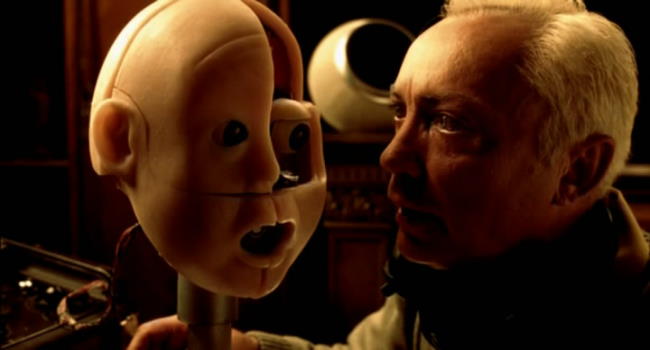
Every character in One Point O is quirky and memorable. Udo Kier (Ralfi from Johnny Mnemonic), one of my favorite role actors, plays an eccentric robotics hobbyist who has a nanotechnology-enabled couch that changes colors and cleans itself at the click of a button, and creates a sentient talking head in his spare time (this talking head named Alex has a penchant for making very prescient phone calls). Bruce Payne (Passenger 57, Hellborn) plays a neighbor VR game maker who creates S&M VR porn experiences by acting out the scenes with various partners. Deborah Kara Unger (Fear X) plays a cancer nurse in search of fleeting humanity wherever she can find it. Lance Henriksen (Bishop in Aliens) plays a strange, zen-like repairman who always seems to know what’s going on. Finally, Emil Hostina places a voyeuristic landlord who loves to eat meat. But its Jeremy Sisto who steals the camera - he’s simply terrific playing a normal guy overtaken by extremely weird events.
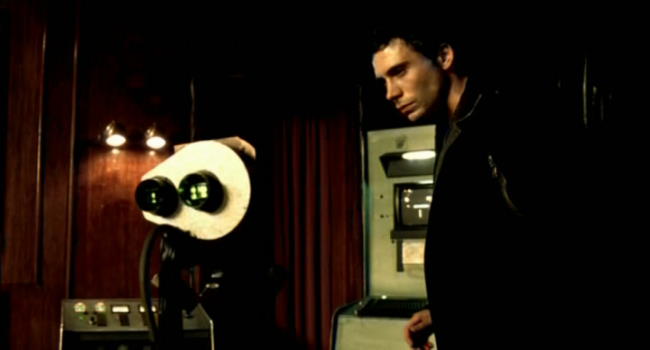
The Visuals: Like many cyberpunk movies, One Point O is dominated by a single color scheme - in this case we get a spectrum, from a yellow to pale orange to reddish-brown, with an occasional pale green as a highlight. Pretty much the whole movie (with the exception of the white convenience store which represents the corporation) takes place in those colors. Further accenting the dystopic quality is the continually run-down feel of the place. The apartment building is continually falling apart, as is virtually everything else except for the local drug store. While its clear that advanced technologies are the norm in this world, the people in One Point O have clearly been marginalized. They play with patchwork toys and out of date technology.
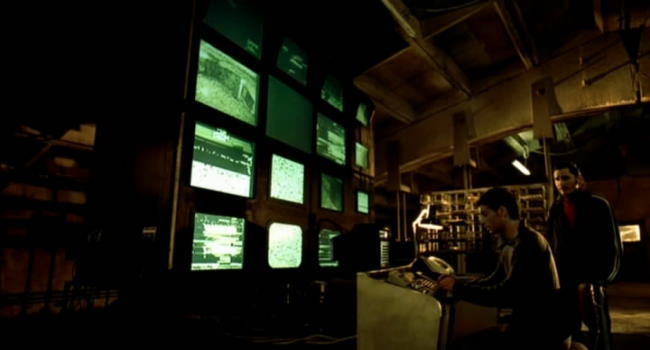
The cinematography is consistently interesting in One Point O, with many using floor shots with expansive backgrounds. However, in some cases, they probably go a bit over-board on the camera angles, such as the use of the close-up phone shot of old, which actually took attention away from the story telling. But again, this is a minor gripe, especially when we include the editing, which for the most part, is also outstanding. But in watching the deleted scenes, I do agree with the director’s commentary that a few shots probably should have been included, most notably the throw-up scene.

The Message: While I can’t go into the actual plot for fear of ruining the experience, I will say that One Point O has perhaps the most biting commentary on advertising and software development you will find anywhere. There is no question who is evil in this movie, even if they are rarely seen. Renfroe and Thorsson take to extremes and then crystallize problems they see in today’s world that form the basis for the story in One Point O. But they don’t state it in an in-your-face way - far to the contrary in fact. The story itself hammers home the message in the starkest manner possible.
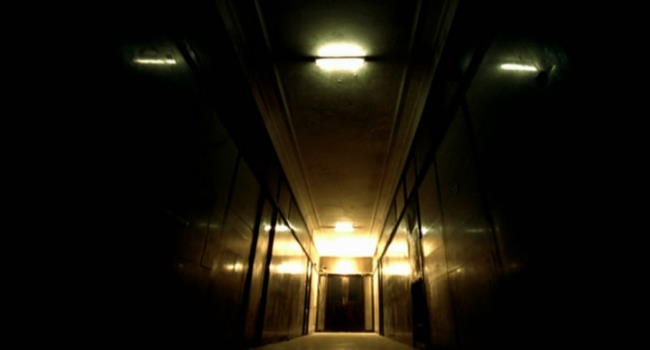
The Bottom Line: As long as you’re not looking for action or sleak visuals, but instead are looking for original cyberpunk themes done wonderfully well on a shoestring budget, One Point O is for you. One Point O is definitely a movie I would LOVE to talk about in detail but I cannot for fear of spoiling the terrific ending (maybe creating a spoiler thread in the meatspace would be the way to discuss it). The pacing has a slightly repetitive feel to it, but only because the movie progresses in a spiral pattern - the same basic pattern of events happen each pass, but events spin further and further out of control each time around. But again - go buy this movie (you’ll want to watch it more than once) - you won’t be disappointed.
~See movies similar to this one~
Tags: cyberpunk movie review paranoia
|
































































